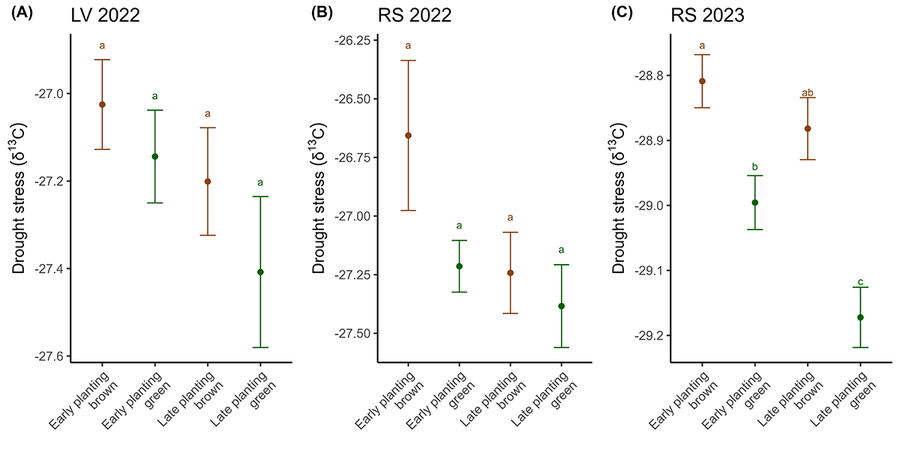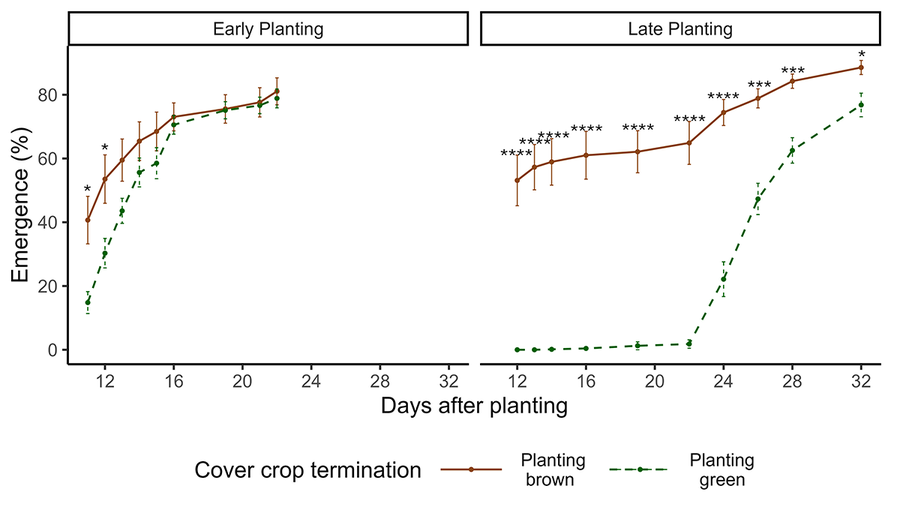Three field experiments were conducted in Landisville (LV, 2022) and Rock Springs (RS, 2022 and 2023), Pennsylvania. The cover crop preceding soybeans was cereal rye in 2022 and triticale in 2023. We compared four treatments:
Treatments and Treatment descriptions
- Early Planting Brown
Soybean planted early (April 25 at LV 2022, May 12 at RS 2022, May 11 at RS 2023), with cover crop terminated two weeks before planting. - Early Planting Green
Soybean planted early (same as above), with cover crop terminated at planting. - Late Planting Brown
Soybean planted late (May 25), with cover crop terminated two weeks before planting. - Late Planting Green
Soybean planted late (May 25), with cover crop terminated at planting.
Study Results
- When soybean was planted early, higher yields were achieved with planting green than planting brown in two of the three experiments (Table 1).
- Within the same soybean planting time, there was no case in which yield was lower with planting green than planting brown.
- Higher yields associated with planting green were likely due to improved soil moisture retention later in the growing season during pod formation and grain filling, and overall lower plant drought stress (as indicated by lower δ13C values in Figure 1).
- Compared to planting brown, planting green reduced soil moisture ahead of soybean planting. In 2023, when we experienced a dry spring, soybean emergence was delayed by about a month in the late planting green treatment compared to late planting brown due to lack of moisture for germination (Figure 2). Therefore, avoid planting green if there is a risk of the soil becoming too dry for soybean establishment. In contrast, planting green may be beneficial during wet springs or in low-lying fields by reducing excess soil moisture and facilitatingearlier soybean planting.
Table 1: Effect of treatments on cover crop biomass (CCB) in tons/acre and soybean grain yield (SGY) in bushels/acre. Different letters indicate significant (p<0.05) differences between treatments within a year and location.
.png)

Figure 1. Effect of treatments on drought stress experienced by soybean plants (indicated by δ13C analysis on soybean grain). Within each experiment, different letters indicate that drought stress was statistically different (p<0.05) between treatments.

Figure 2. Soybean emergence (% of seeding rate) in RS 2023 experiment. Asterisks represent significant differences between treatments within each day (*p<0.05, **p<0.01, ***p< 0.001, ****p<0.0001).
Source : .psu.edu